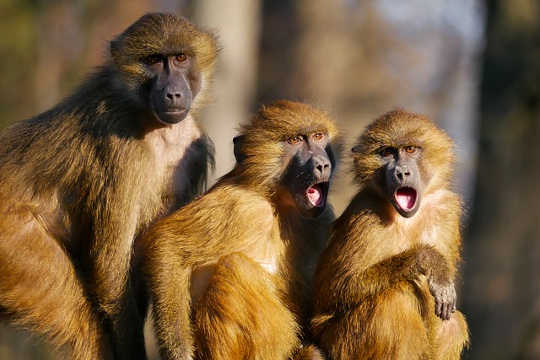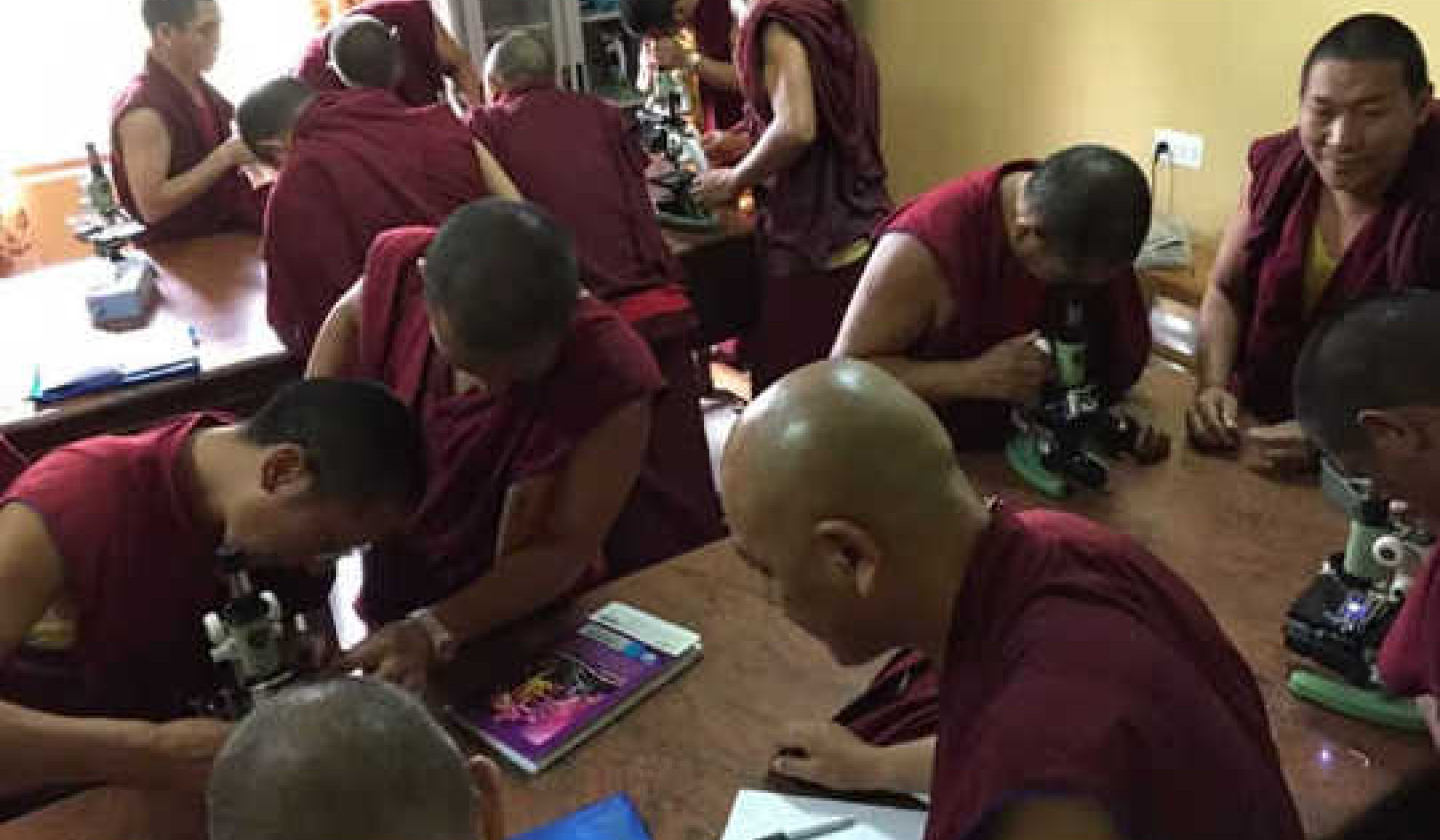 Image by Gerhard Gellinger
Image by Gerhard Gellinger
I have always found it interesting and surprising that in Joseph Campbell’s model of the hero’s journey, the second stage after “the calling” is “refusing the call.” In stories, the hero will get a clear calling but then immediately be filled with doubt, hesitation, or outright fear. Seeing clearly means acknowledging pain, failure, and limits.
Evolutionary biology tells us that the human species evolved over millions of years for one thing and one thing only — to survive and pass on our genes to the next generation. We evolved to feel fear, to be dissatisfied, and to need connection. These inherited, evolved characteristics can be barriers to love and internal obstacles to mindful leadership. In short, in most situations, our first instinct is self-preservation, and we tend to pull back when we feel at risk.
We Are Descendants Of The Nervous Apes!
Mario, a Google scientist friend, is fond of saying, “We are descendants of the nervous apes!” The apes that were chill and relaxed, they didn’t make it. They didn’t survive. They were killed or eaten by predators.
As descendants of the nervous apes, our tendency is to scan for threats, both external threats in our environment and internal threats. In the realm of survival, it’s better to be wrong 99 percent of the time and right 1 percent of the time. This is essential when physical safety is all that matters. In that case, it’s wise to treat any potential threat as a life-or-death situation.
Yet this mindset doesn’t fit today’s world and can be problematic. The world remains full of threats, but relatively few to our life. Yet our nervous system reacts in virtually the same way: Whether we’re responding to an angry email or a hungry tiger, the same alarm bell (the amygdala) rings in our brains and our sympathetic nervous system kicks into action.
Internally, this process of scanning for threats laid the ground for our strong inner critic as well as our negativity bias. Research has shown that we often judge ourselves harshly and that we tend to experience negative emotions more quickly and with greater intensity than positive emotions. The nervous ape doesn’t like to be vulnerable or ask difficult questions. Reality can feel threatening. Of course, we may truly believe that loving the work and seeing more clearly is the better approach — the true path to sustainable safety, satisfaction, and success — but the nervous ape needs calming and convincing to go that route.
We Are Also Descendants Of The Imaginative Apes
At some point, our ancestors developed consciousness, the ability to be present not only for whatever we are doing in the moment but to recall the past and imagine the future. Indeed, in our minds, we can conjure just about any scenario or reality we want! This is truly amazing. We not only take consciousness for granted, we rarely acknowledge the magic of our imaginations.
Consciousness itself is truly astounding; it remains a mystery where it came from and all that it can do. And there’s more. Our imaginations allow us to create an identity, a self. This self both influences and is influenced by a host of thoughts, feelings, emotions, assumptions, and beliefs — some based on actual events, and many based on imagined events — to form a “me,” an “I,” an individual life. Then, together with our families, friends, organizations, and culture, we create entire societies and worlds, which are really incredible stories of our collective imaginations — what we call laws, borders, marriage, institutions, money, and much more.
Oddly enough, despite this unlimited power to conjure, the imaginative ape is rarely satisfied. It seems that another aspect of human evolution and human nature is nearly always wanting more and better — more and better food, sex, money, status, whatever. The imaginative ape is often comparing, contrasting, judging, and thinking ahead, so we are almost perpetually focused, on some level, on what we lack relative to others or to what we want. Even when we get what we want, we can easily imagine the possibility of loss, which undermines our satisfaction.
Of course, the ability to judge and plan for potential threats is a big positive for our survival, but not so much for seeing clearly. It’s not as though once we have great sex or a tasty meal, we are then satiated and complete. No, these feelings and experiences of satisfaction wear off, and we start to search for more.
Thus, the imaginative ape also represents another potential obstacle on the path to mindful leadership. The good news is that we can train our imaginations to be more satisfied, more complete, more able to remain in the present moment, as opposed to ruminating on the past, imagining what we lack, anticipating negative futures, and assuming (often inaccurately) the thoughts and intentions of others.
We Are Also Descendants Of The Empathic, Social Apes
We need connection, and we are hardwired to feel the feelings, pains, and joys of others, along with the many nuanced emotions in between. Though this ability has been understood experientially for a long time, it was first confirmed scientifically in a 1982 study done (ironically) with monkeys. Researchers at the University of Parma, Italy, discovered that neurons fire in the same area of the brain whether a person is performing an action, like eating, or merely observing someone else doing the same thing.
As with the other two, this trait is likely evolved; individual survival, and raising the next generation, is of course improved when individuals work together. Humans have a profoundly strong and primal need for connection to others. Our identities, our sense of meaning and purpose, the way we see ourselves, and the way we process thoughts, emotions, and actions — all are formed and intertwined within our relationships with family members, friends, coworkers, and all the people who make up the web of communities we are part of.
However, this puts a premium on choosing or aligning with others we can trust, understand, and communicate with, and often the need to feel safe and the need to feel connected can be at odds. The empathic ape wants to foster connections to a small group, family, or tribe, but it fears disconnection within this group. Conversely, it tends to treat anyone outside that family, tribe, or group identity as a threat.
Three Core Human Needs: Safety, Satisfaction, and Connection
Seen in a positive light, these “three apes” represent three core human needs: safety, satisfaction, and connection. They also make useful metaphors for our three primary centers: body, mind, and heart.
Yet the three apes also tend to react first, or express themselves initially, in negative ways: The nervous ape easily feels fear for personal safety. The imaginative ape easily feels dissatisfied with self and others. And the empathic ape easily fears and fosters division.
In other words, the three apes represent the tremendous potential of human beings:
(1) a strong sense of self-preservation that inspires courageous feats,
(2) an incredibly advanced and developed imagination, and
(3) a strong need for connection and the ability to communicate and understand emotions.
But that potential cuts two ways. The same attributes that help us succeed when we feel the call of mindful leadership may also respond by refusing that call in the name of safety and self-protection.
The Two Potentials
We have the potential to live in a world of confusion, of misunderstanding — to create a world based primarily on fear and mistrust, to enhance and increase this fear using our imaginations, and to ignore our similarities and emphasize our differences. This path is likely to result in increased individual stress and unhappiness, greater inequality and separation, more misunderstanding and more violence. To our dismay, this often seems to be the world we have created, the one we are currently living in.
Or, as mindful leaders, we can cultivate love and understanding: We can acknowledge our vulnerability and tendencies to respond strongly to threats, and we can use our imaginations to calm, retrain, and transform our fears. We can cultivate more trust of ourselves. And we can acknowledge the reality of our interconnectedness by looking deeply at our profound similarities.
We can see that we are all part of the human family, living on and sharing one planet. We can aspire to create another reality — the reality of trust and understanding, using our innate abilities for empathy and compassion. We can transform fear to hope and possibility and move toward creating a life of more meaning and satisfaction, of greater connection, health, and cooperation.
Try This Experiment
TRY THIS: As an experiment, consider the three apes inside yourself. Take a moment to greet and get to know them. For instance, the nervous ape: Take a few moments to bring attention to when you feel safe and when you are scanning for threats. Reflect on and relive as much as possible particular situations in recent days or weeks. Where in your body do you feel safe, and what is the feeling of scanning for threats or of feeling fear?
As for the imaginative ape, bring attention to your need for satisfaction, for food, for sex, or for distractions. Just notice: What are your thoughts that lead to satisfaction or to dissatisfaction? Again, reflect on how you interact with those you work with or people in your personal life.
Now, the empathic ape: What is it like to feel the emotions of others? Bring awareness to this ability. Bring attention to your need for connection. What supports your feeling of connection and what gets in the way? Be as specific, curious, and honest with yourself as possible. If you want, write about what you discover.
Identifying Creative Gaps and Ground Truths
Through mindfulness, our intention is to recognize change, recognize what is, and recognize our aspirations, but the three apes may feel threatened by some or all of this. We should expect to encounter and have to overcome some internal resistance, which is part of the process of seeing more clearly.
For instance, reality has an irritating habit of shifting and changing, totally undermining our hopes, dreams, and fantasies. When our ideas and plans collide with reality, reality generally wins, whether it’s the reality of our aging bodies and minds, of our mercurial emotions, of upheaval in the business world, or of the shifting priorities and feelings of other people — family, friends, and coworkers.
When this happens, we may not want to admit that reality isn’t going to meet our expectations, but we create trouble for ourselves if we do not. We need to see what is, or what the military calls “ground truth.” This is what’s actually happening, the reality of the battle or situation on the ground, as opposed to what intelligence reports and mission plans predicted would happen.
The ground truth is what you say to yourself and closest friends about the reality of your experience, as opposed to what you want, or what you hoped or planned would happen, or how you’d like to appear to others.
For a moment, consider your “ground truth” in these areas:
- YOUR WELL-BEING, including sleep, exercise, diet, and your state of mind: What are you experiencing versus your aspirations?
- YOUR WORK: How’s it going? What’s the reality?
- YOUR EXPERIENCE OF YOUR CORE RELATIONSHIPS: Would you say you are satisfied or disappointed, and how?
In war and in life, there are always gaps between our ground truths and our visions of what we expected or wanted. Naturally, we’d like to close these gaps if we can, but first we have to see and acknowledge them. So, one important practice is to acknowledge where you are right now, where you want to be, and the gaps between these two. Doing this requires being curious, appreciative, and warmhearted with yourself while at the same time “staring,” looking directly at what is and what you want. This is an important, even paradoxical skill and practice: acknowledging the gaps between what is (the ground truth) and what you want, while at the same time appreciating what is without trying to change it.
In his groundbreaking book The Fifth Discipline, Peter Senge calls these gaps “creative tensions.” He says that one of the most important skills of leadership is staying with these gaps instead of covering them over or finding strategies to make them go away in order to feel more comfortable.
TRY THIS: Having considered your “ground truth” in several areas, identify some of your core or most critical creative gaps. In what areas is the difference between what actually is and your vision of what you want the widest? What are some ways you might narrow or even close those gaps?
What support do you need?
What skillful conversations might be useful?
What has stopped you from closing the gaps up to now?
What might you need to accept rather than change?
What is there to learn?
Copyright ©2019 by Marc Lesser. All Rights Reserved.
Printed with permission from New World Library
www.newworldlibrary.com
Article Source
Seven Practices of a Mindful Leader: Lessons from Google and a Zen Monastery Kitchen
by Marc Lesser
 The principles in this book can be applied to leadership at any level, providing readers with the tools they need to shift awareness, enhance communication, build trust, eliminate fear and self-doubt, and minimize unnecessary workplace drama. Embracing any one of the seven practices alone can be life-changing. When used together, they support a path of well-being, productivity, and positive influence.
The principles in this book can be applied to leadership at any level, providing readers with the tools they need to shift awareness, enhance communication, build trust, eliminate fear and self-doubt, and minimize unnecessary workplace drama. Embracing any one of the seven practices alone can be life-changing. When used together, they support a path of well-being, productivity, and positive influence.
Click here for more info and/or to order this paperback book. Also available in a Kindle edition.
About the Author
 Marc Lesser is a CEO, Zen teacher, and author who offers trainings and talks worldwide. He has led mindfulness and emotional intelligence programs at many of the world’s leading businesses and organizations, including Google, SAP, Genentech, and Twitter. You can learn more about Marc and his work at www.marclesser.net and www.siyli.org.
Marc Lesser is a CEO, Zen teacher, and author who offers trainings and talks worldwide. He has led mindfulness and emotional intelligence programs at many of the world’s leading businesses and organizations, including Google, SAP, Genentech, and Twitter. You can learn more about Marc and his work at www.marclesser.net and www.siyli.org.
Books by this Author
at InnerSelf Market and Amazon



























